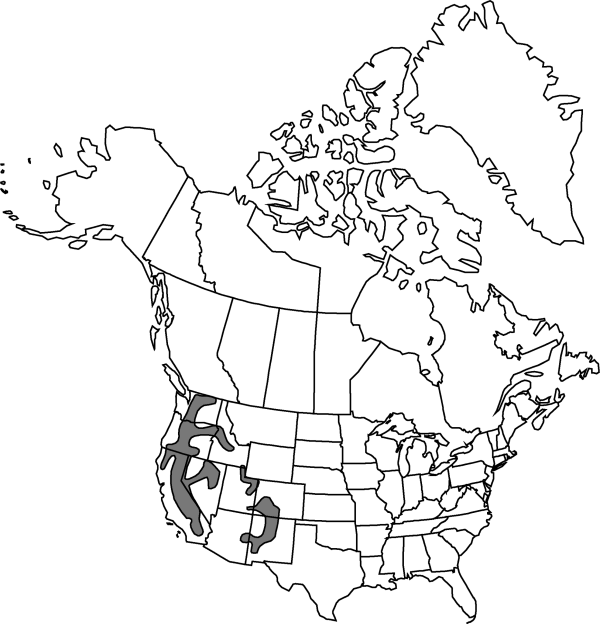Lewisia nevadensis
in A. Gray et al., Syn. Fl. N. Amer. 1: 268. 1897.
Taproots napiform to shortly fusiform. Stems suberect, becoming horizontal or deflexed after anthesis, base subterranean, 5–12 cm. Leaves: basal leaves withering at or soon after anthesis, gradually narrowed to broad petiole, blade narrowly linear to linear-oblanceolate, flattened, 4–15 cm, margins entire, apex obtuse to subacute; cauline leaves absent. Inflorescences usually with flowers borne singly, rarely 2–3-flowered in racemose cymes; bracts 2, opposite, linear-lanceolate, 6–18 mm, margins entire, apex acute. Flowers pedicellate, not disarticulate in fruit, 0.5–2 cm diam.; sepals 2, broadly ovate, 5–13 mm, herbaceous at anthesis, margins entire or with few shallow, nonglandular teeth, apex acute to subacute; petals 5–10, white or rarely pinkish, elliptic to oblanceolate, 10–15 (–20) mm; stamens 6–15; stigmas 3–6; pedicel 10–40 mm. Capsules 5–10 mm. Seeds 20–50, 1.3 mm, shiny, muricate. 2n = 56.
Phenology: Flowering late spring–late summer.
Habitat: Wet grassy slopes and meadows near springs
Elevation: 1300-3200 m
Distribution

Ariz., Calif., Colo., Idaho, Nev., N.Mex., Oreg., Utah, Wash.
Discussion
Lewisia nevadensis represents one extreme of the L. pygmaea complex (see discussion under 13. L. pygmaea). Questionable geographic occurrences reflect plants that have one or more features otherwise suggestive of L. pygmaea (e.g., more elongate roots, truncate and/or toothed sepals, and colored petals); such intermediates also occur in the range of “typical” L. nevadensis (relatively robust plants with napiform roots, solitary flowers, acute sepals with entire margins, and white petals). Uncertainty respecting the affinity of specimens prevails in those from Arizona, Colorado, Idaho, and Wyoming. There are no supporting specimens from Wyoming.
B. L. Davidson (2000) noted that Lewisia nevadensis is a garden weed in Colorado; it is not clear whether or not these plants are escapes from cultivation.
The floral symmetry of Lewisia nevadensis may be somewhat elliptical, the two outer sepals and the remaining petals imbricate and opposite the sepals, giving the flowers a pinched appearance, a feature also reported for L. oppositifolia.
Selected References
None.
Lower Taxa
"broad" is not a number."broad" is not a number.